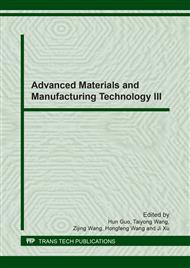[1]
Said Mousavi, Vincent Gagnol, Belhassen C. Bouzgarrou, Pascal Ray (2017) Control of a Multi Degrees Functional Redundancies Robotic Cell for Optimization of the Machining Stability. Procedia CIRP 58 : 269 – 274.
DOI: 10.1016/j.procir.2017.04.004
Google Scholar
[2]
Hamade RF, Ismail F (2005) A case for aggressive drilling of aluminum. J Mater Process Technol 166(1): 86-97.
Google Scholar
[3]
Miller WS, Zhuang L, Bottema J, Wittebrood AJ, De Smet P, Haszler A, Vieregge A (2000) Recent development in aluminum alloys for the automotive industry. Mater Sci Eng A 280 (1): 37-49.
DOI: 10.1016/s0921-5093(99)00653-x
Google Scholar
[4]
Ding X, Liew WYH, Liu XD (2005) Evaluation of machining performance of MMC with PCBN and PCD tools. Wear 259(7): 1225-1234.
DOI: 10.1016/j.wear.2005.02.094
Google Scholar
[5]
Jr MCS, Machado AR, Sales WF, Barrozo MAS, Ezugwu EO (2016) Machining of aluminum alloy: a review. International Journal of Advanced Manufacturing Technology : 1-14.
Google Scholar
[6]
Wiercigroch M, Krivtsov AM (2001) Frictional chatter in orthogonal metal cutting. Philos Trans R Soc A Math Phys Eng Sci 359(1781): 713–38.
DOI: 10.1098/rsta.2000.0752
Google Scholar
[7]
Rao B C, Shin Y C (1999) A comprehensive dynamic cutting force model for chatter prediction in turning. International Journal of Machine Tools and Manufacture 9(10): 1631-1654.
DOI: 10.1016/s0890-6955(99)00007-3
Google Scholar
[8]
Altintas Y (2000). Manufacturing automation, metal cutting mechanics, machine tool vibrations and CNC design. The Edinburgh Building, Cambridge CB2 2RU, UK: Cambridge University Press.
DOI: 10.1017/cbo9780511843723
Google Scholar
[9]
Chandiramani N K, Pothala T (2006). Dynamics of 2-dof regenerative chatter during turning. Journal of Sound and Vibration 290(1-2): 448-464.
DOI: 10.1016/j.jsv.2005.04.012
Google Scholar
[10]
Onik Bhattacharyya, Shiv G. Kapoor, Richard E. De Vor (2006). Mechanistic model for the reaming process with emphasis on process faults. Int J Mach Tools & Manuf 46: 836-846.
DOI: 10.1016/j.ijmachtools.2005.07.022
Google Scholar
[11]
Xia RA, Mahdavian SM (2004) Experimental studies of step drills and establishment of empirical equations for the drilling process. Int J Mach Tools Manuf 45(2): 235-240.
DOI: 10.1016/j.ijmachtools.2004.07.002
Google Scholar
[12]
Qian Q, Wei G, Hua H, Fang Z (2010) The compound tool of drilling-reaming and rounding chamfer. Fourth International Seminar on Modern Cutting & Measurement Engineering 7997: 79970G-79970G-6.
DOI: 10.1117/12.892057
Google Scholar
[13]
Lugscheider E, Knotek O, Barimani C, Leyendecker T, Lemmer O, Wenke R (1997) Investigations on hard coated reamers in different lubricant free cutting operations. Surface Coatings Technol 90(1-2): 172-177.
DOI: 10.1016/s0257-8972(96)03114-3
Google Scholar
[14]
Bezerra AA, Machado AR, Souza AM, Ezugwu EO (2001) Effect of machining parameters when reaming aluminum-silicon(SAE322) alloy. J Mater Process Technol 112(2-3): 185-198.
DOI: 10.1016/s0924-0136(01)00561-1
Google Scholar
[15]
Sushpal Singh Chatha, Amrit Pal, Tarjeet Singh (2016) Performance evaluation of aluminum 6063 drilling under the influence of nanofluid minimum quantity lubrication. Journal of Cleaner Production 137: 537-545.
DOI: 10.1016/j.jclepro.2016.07.139
Google Scholar
[16]
Perviaz S, Deiab I (2015) Surface roughness and energy consumption analysis of conventional and peck drilling approaches. J Eng Manuf 299(12): 2180-2195.
Google Scholar
[17]
Jochem C. Roukema, Yusuf Altintas (2007) Generalized modeling of drilling vibrations. Part I: Time domain model of drilling kinematics, dynamics and hole formation. Int J Mach Tools Manuf 47: 1455-1473.
DOI: 10.1016/j.ijmachtools.2006.10.005
Google Scholar
[18]
Chevrieer P, Tidu A, Bolle B, Cezard P, Tinnes JP (2003) Investigation of surface integrity in high speed end milling of low alloyed steel. Int J Mach Tools Manuf 43(11): 1135-1142.
DOI: 10.1016/s0890-6955(03)00122-6
Google Scholar
[19]
Zhang G, Li J, Chen Y, Huang Y, Shao X, Li M (2014) Prediction of surface roughness in end face milling based on Gaussian process regression and cause analysis considering tool vibration. Int J Adv Manuf Tech 75(9): 1357-1370.
DOI: 10.1007/s00170-014-6232-6
Google Scholar


